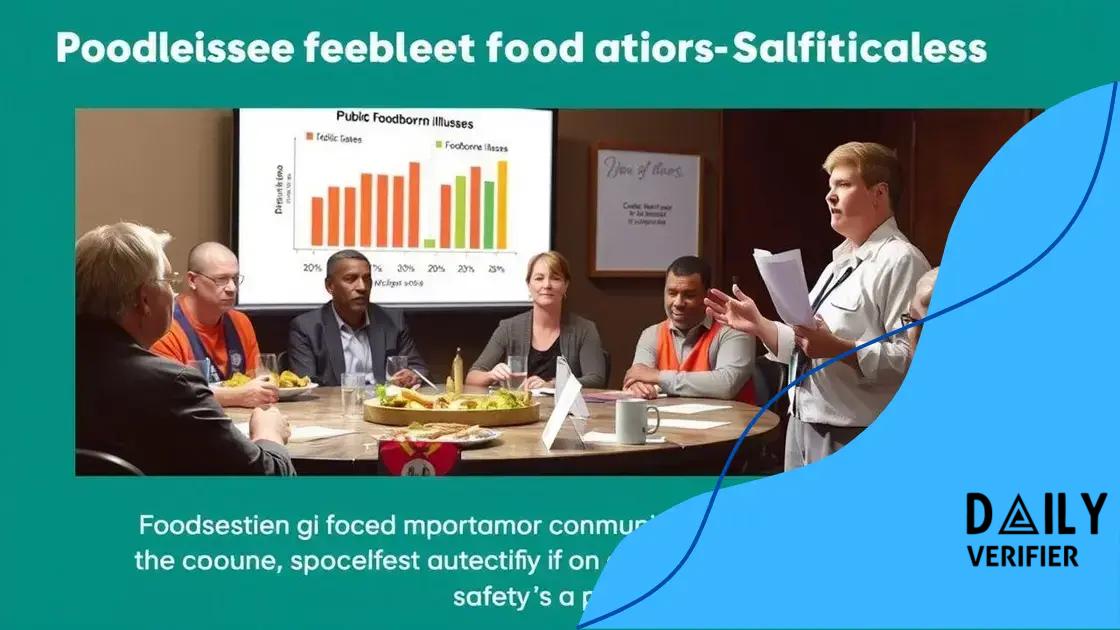Food safety policy under review: what you need to know

Food safety policy under review highlights essential changes like technology integration, consumer transparency, and sustainability, aiming to improve protection against foodborne illnesses and build trust in the food supply chain.
Food safety policy under review is a topic that directly impacts consumers and businesses alike. Have you ever wondered how these policies can affect what you eat? Let’s dive into the pressing updates that are on the table right now.
Current state of food safety policies
The current state of food safety policies is critical to ensuring that our food remains safe to consume. These regulations help protect public health and maintain trust in the food supply chain. Every year, thousands of people can fall ill due to unsafe food practices.
Key Aspects of Food Safety Policies
Understanding the main components of food safety policies can shed light on their importance. For instance, regulations are typically designed to:
- Minimize contamination risks during food processing.
- Ensure proper food handling in restaurants and stores.
- Promote consumer education on safe food practices.
These guidelines are not just rules; they represent a framework for how food businesses operate. Compliance with these regulations is crucial for businesses to maintain their license to operate and to ensure consumer safety. However, not all policies are equally updated or enforced, leading to gaps in food safety.
Challenges in Implementing Current Policies
Despite the existence of established guidelines, the implementation can still face several challenges. Some of these include:
- Lack of funding for food safety agencies.
- Inconsistent training for food handlers.
- Challenges in monitoring food sources during transportation.
These challenges make it vital for authorities to address the gaps and improve the systems in place. Continuous training and education for food industry workers can bridge many of these gaps, ensuring compliance with food safety standards.
Key changes and their implications
Understanding the key changes in food safety policies is essential for both consumers and food industry professionals. With advancements in technology and emerging health concerns, these updates play a crucial role in protecting public health.
Recent Developments
One significant area of change includes updates in labeling requirements. Consumers are now more aware of what they are eating. Clear labeling helps people make informed choices regarding allergens and nutritional content. This shift aims to enhance transparency within the food industry.
- Mandatory allergen information on packaging.
- New nutritional guidelines reflecting recent dietary research.
- Increased penalties for non-compliance to ensure adherence.
Another important update involves stricter sanitation standards. Food establishments are now required to adopt enhanced hygiene practices to minimize contamination risks. This change not only helps prevent foodborne illnesses but also boosts consumer confidence.
Impact on Food Businesses
These changes can significantly affect how food businesses operate. For instance, companies may need to invest in better training for their staff on the new regulations. This additional responsibility may also lead to increased operational costs in the short term.
Moreover, small businesses might find it challenging to keep up with the evolving requirements. Non-compliance can lead to hefty fines or even closing of the establishment. It’s vital for these businesses to stay informed and adapt accordingly to remain competitive.
The focus on sustainability is another shift in food policies. Sustainable practices are encouraged, influencing everything from sourcing ingredients to waste management. This trend reflects the growing consumer preference for eco-friendly products.
Impact on public health and consumer safety

The impact on public health and consumer safety from food safety policies is profound. Ensuring safe food practices not only protects individual health but also enhances community well-being. Each change in policy can ripple through both consumers and businesses.
Health Benefits of Strong Food Safety Policies
Effective food safety regulations can lead to a marked decrease in foodborne illnesses. When policies are followed diligently, the risk of contamination drops significantly. This reduction is vital in preventing outbreaks of diseases like salmonella and E. coli.
- Improved regulations decrease the incidence of foodborne illnesses.
- Enhanced hygiene standards help protect vulnerable populations.
- Public trust in the food supply increases when safety measures are enforced.
Consumers are more likely to buy products from businesses that adhere to strict safety standards. This trust drives sales and encourages businesses to prioritize health and safety measures.
Challenges to Consumer Safety
However, there are challenges related to public health. Not all establishments comply with food safety guidelines, which can place consumers at risk. Education is key in informing the public about safe food-handling practices. Informed consumers are better equipped to make safe choices.
Additionally, the food supply chain is complex. From farms to grocery stores, many factors can influence food safety. Issues like transportation and storage can introduce new risks. Continuous monitoring and enforcement are necessary to address these challenges.
Ultimately, collaborative efforts between government agencies, businesses, and consumers are required to ensure food safety. This combined approach fosters a safer food environment for all.
Challenges in food safety regulation
The challenges in food safety regulation are numerous and complex. As global food systems grow and evolve, keeping pace with safety requirements becomes increasingly difficult. Various factors contribute to these challenges, affecting both enforcement and compliance.
Inconsistent Enforcement
One significant issue is the lack of consistent enforcement of food safety regulations. In many areas, there are inadequate resources for inspections and monitoring. This can lead to a patchwork of compliance, where some businesses meet standards while others do not.
- Infrequent inspections can miss violations.
- Smaller businesses often lack knowledge of regulations.
- Varying state and local laws can confuse businesses.
This inconsistent enforcement can compromise consumer safety, as some establishments may operate without meeting required standards.
Education and Training Gaps
Another challenge is the gap in education and training among food handlers. Proper training is essential to ensuring food safety in every step of the food supply chain. Unfortunately, many workers do not receive adequate training on food safety practices.
Without proper knowledge, employees may unintentionally contribute to unsafe conditions. Continuous education helps to maintain high standards but is often overlooked.
Moreover, the rapid pace of change in regulations can leave food businesses scrambling to keep up. They may need to adapt quickly to new rules without the support of adequate resources. This can particularly affect small businesses that already operate under tight budgets.
Ultimately, addressing these challenges requires a collective effort from regulators, food businesses, and the community. By improving enforcement consistency and enhancing education efforts, the food safety landscape can be made safer for everyone.
Future of food safety policy: trends and expectations
The future of food safety policy is poised for significant transformation as new trends and expectations emerge. With the world becoming more interconnected, the approach to food safety regulation must adapt to meet changing consumer needs and technological advancements.
Embracing Technology
One of the most notable trends is the increased use of technology in food safety. Advances like blockchain and artificial intelligence are being implemented to track food products throughout the supply chain. This technology enhances traceability and helps quickly identify outbreaks when they occur.
- Blockchain improves transparency in food sourcing.
- AI analyzes data to predict potential contamination risks.
- Mobile apps are used for food safety training and compliance tracking.
As these technologies become standard, businesses will need to invest in training their employees to effectively utilize them. This shift not only helps in compliance but also builds consumer trust.
Consumer Demand for Transparency
Another trend shaping the future of food safety policies is the growing demand for transparency. Consumers want to know where their food comes from and how it is handled. This expectation pushes businesses to adopt clearer labeling practices and more rigorous safety measures.
Incorporating sustainability practices into food safety is also critical. As people become more environmentally conscious, food policies must reflect these values. This includes reducing food waste and minimizing the use of harmful chemicals.
Furthermore, there is a push for global cooperation in food safety. As food systems become more interconnected, a unified approach to food safety is essential. This may involve international standards and shared resources, ensuring that food safety practices are aligned across borders.
FAQ – Frequently Asked Questions About Food Safety Policy
What are the key trends in food safety policy?
Key trends include increased use of technology, consumer demand for transparency, and a focus on sustainability within food safety practices.
How does technology improve food safety?
Technology, such as AI and blockchain, enhances tracking and traceability, allowing for quick identification of foodborne illnesses.
Why is consumer transparency important in food safety?
Consumer transparency helps build trust, ensuring customers know how their food is sourced and handled, which directly impacts their safety.
What challenges do food businesses face in complying with safety regulations?
Challenges include inconsistent enforcement of regulations, gaps in education and training for food handlers, and the complexity of evolving laws.






